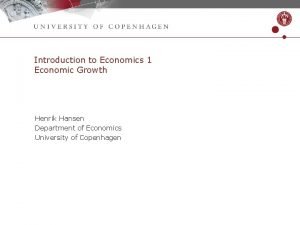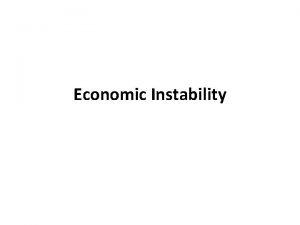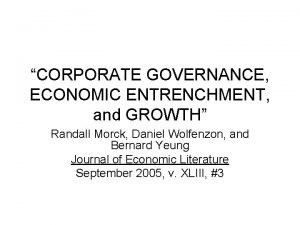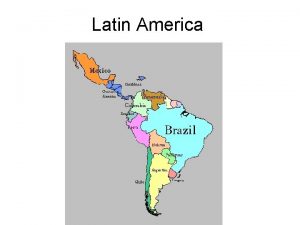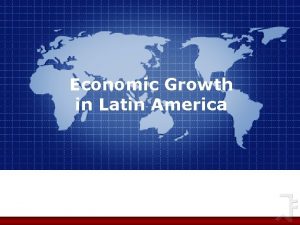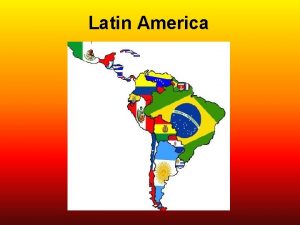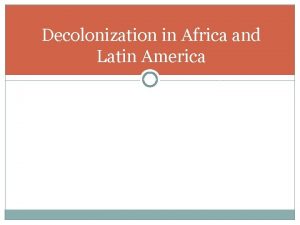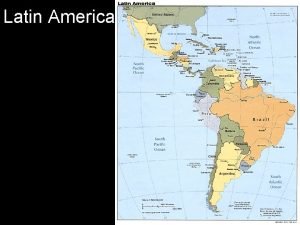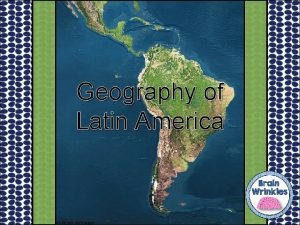Economic Growth in Latin America Past Present and
































- Slides: 32

Economic Growth in Latin America: Past, Present and Future Perspectives. Andrés Solimano ECLAC, United Nations November 11, 2004

Table of Contents A. The Recent Growth Performance of Latin America B. The Growth Record of Latin America of the Last Four Decades C. Volatility D. Changes in Growth Performance E. Towards Explaining Growth Performance F. Future Prospects

A. The Recent Growth Performance of Latin America


Figure 2. PROJECTED GROWTH RATE BY COUNTRY, 2004 América Latina y el Caribe: 4, 5%


Table 1 Savings, Investment and Growth Latin America and the Caribbean, 1990 -2003. 1990 -1997 Rate of Growth (% per year) GDP per capita Gross Capital Formation (% of GDP) 1998 -2003 3. 2 1. 4 1. 3 -0. 2 22. 4 19. 3 19. 6 17. 8 2. 9 1. 5 National Savings (% of GDP) Foreign Savings (% of GDP) Source: Preliminary overview of the economies of Latin America and Caribbean, ECLAC 2003.

B. The Growth Record of Latin America of the Last Four Decades

Economic Growth in Latin America 1960 -2004 Four stylized facts of economic growth in L. A. that define risks and prospects of growth Economic growth has been slow and very volatile. High heterogeneity in degree of development across Latin American countries. Economic growth has declined since early 1980 s. Important changes in relative growth performance, including the economic collapse of some countries. Few cases of rapid and sustained growth after 1990.



C. Volatility

Economic growth has been slow and volatile Average annual growth rate of per capita GDP in 19602002 Latin America: 1. 6% per capita US: 2. 5% South Korea: 6% 100 to 192 100 to 275 100 to 990 Instability: years with recessions (negative GDP growth) Average for Latin American countries: 16 of 42 US: 8 of 42 South Korea: 4 of 42


Frequency of Growth Crisis: Unstable Growth Table 4 Growth Crisis in Latin America and Control Group Number of years with negative GDP Percentage of growth rates crisis in total period 1960 -1980 1981 -2002 1961 -2002 Latin American Countries Argentina Bolivia Brazil Chile Colombia Costa Rica Dom. Republic Ecuador Mexico Peru Uruguay Venezuela Average Control group Korea Thailand Philippines Ireland Spain Turkey Average 6 4 3 6 0 2 4 2 0 5 6 6 3. 7 11 10 9 3 7 8 4 8 8 10 9 12 8. 3 17 14 12 9 7 10 8 15 15 18 11. 9 41. 5 34. 1 29. 3 22. 0 17. 1 24. 4 19. 5 36. 6 43. 9 29. 3 2 0 0 1 2 5 1. 7 1 2 7 2 2 6 3. 3 3 2 7 3 4 11 5 7. 3 4. 9 17. 1 7. 3 9. 8 26. 8 12. 3 Source: Own elaboration based on ECLAC and IMF data.

D. Changes in Growth Performance

Changes in Growth Performance Across Countries in Latin American Economies


Table 6 Growth Booms in Latin America and Other Countries Bolivia 1965 -1973 Brazil 1971 -1980 Chile 1986 -1997 Colombia 1968 -1974 Costa Rica 1965 -1974 Dom. Republic 1992 -2000 Ecuador 1972 -1980 Mexico 1963 -1970 Korea 1963 -1971 1982 -1991 Ireland 1994 -2001 Spain 1961 -1974 Thailand 1986 -1996 Sustained growth per-capita GDP growth rates above 2 per year for 6 continuous years or more Length of the cycle in Cumulative Contribution of years growth in per Total Factor Capital and Labor capita GDP Productivity 9 34. 8 36. 7 -1. 9 10 67. 7 32. 5 35. 2 11 91. 1 55 46. 5 7 24. 9 20 4. 9 10 41. 9 23 18. 9 9 51. 1 29 22. 1 9 53. 6 40. 1 23. 5 8 33. 5 25 8. 3 9 10 8 67. 7 56. 5 64. 5 42. 1 35. 9 39. 6 25. 6 26. 6 34. 9 14 112. 4 81. 9 40. 5 11 124. 5 54. 7 69. 8

Table 7 Anatomy of Growth Booms Country and Growth Booms Period* Per capita Gross Domestic Product (annual growth rate) Bolivia 1965 -73 Brazil 1971 -80 Chile 1986 -97 Colombia 1968 -74 Costa Rica 1965 -74 Dominican Rep. 1992 -2000 Ecuador 1972 -80 Mexico 1963 -70 National Saving External Financing Investment Term of Trade (Index 1995=100) Memo(average of four years before) National External Investment Term of Saving Financing Trade (Percentages of Gross Domestic Product) (Index 1995=100) 3. 3 13. 8 3. 0 16. 8 138. 5 10. 1 6. 0 16. 1 108. 9 5. 5 17. 9 4. 1 22. 1 89. 4 15. 9 1. 4 17. 4 90. 2 5. 3 19. 1 3. 2 22. 3 92. 5 4. 8 9. 0 13. 9 145. 9 3. 8 13. 7 3. 0 16. 7 97. 1 15. 2 2. 6 17. 7 97. 1 4. 1 10. 6 8. 8 19. 4 72. 4 12. 3 3. 8 16. 1 74. 1 4. 6 18. 6 3. 5 22. 1 99. 0 22. 0 2. 7 24. 8 129. 7 3. 9 17. 7 4. 1 21. 8 188. 6 9. 5 7. 3 16. 8 105. 6 3. 8 16. 5 1. 8 18. 3 182. 1 13. 4 1. 0 14. 4 187. 4 Source: Economic Survey of Latin America of ECLAC (various), IFC(2002) and Maddison(2003). * per capita GDP growth rates above 2 per year for 6 continuous years or more.

E. Towards Explaining Growth Performance

Why so different development paths? Analysis of sources of economic growth Physical capital accumulation: high and neutral Human capital accumulation: low and neutral Technology adoption and use (TFP): main determinant TFP accounts for most of the evolution of per-capita GDP in each country the decline in growth after 1980, avg. TFP growth is 0%. changes in performance for • collapses: • stagnations: • booms: Venezuela Mexico Chile -1. 3% -0. 3% 3. 5% South Korea: 3. 7% per year since 1960 per year since 1980

Table 8 Growth Accounting for Latin American Economies


Table 10 Latin America. Rate of Growth of GDP and Total Factor Productivity Growth (TFP) Country Argentina Bolivia Brazil Chile Colombia Costa Rica Dominican Republic Ecuador Mexico Peru Uruguay Venezuela Latin America Simple average Weighted average Average annual GDP growth rates (%) 1960 -1980 1981 -2002 1990 -2002 1960 -2002 4. 2 0. 8 2. 2 2. 4 4. 7 2. 0 3. 5 3. 3 7. 2 1. 8 4. 3 3. 5 4. 7 5. 8 4. 1 5. 3 2. 9 2. 5 4. 1 6. 2 3. 7 4. 9 7. 3 4. 9 6. 3 5. 6 8. 4 2. 1 2. 2 4. 6 6. 8 2. 5 3. 0 4. 5 4. 6 1. 8 3. 9 3. 1 2. 2 0. 8 1. 4 1. 5 5. 1 1. 0 1. 3 3. 0 5. 5 6. 1 2. 4 2. 1 3. 2 2. 5 3. 8 4. 0 Average annual rate of growth of TFP (%) 1960 -1980 1981 -2002 1990 -2002 1960 -2002 1. 8 -0. 3 1. 2 0. 7 2. 2 -0. 8 0. 3 0. 6 2. 0 -1. 1 -0. 5 0. 4 1. 3 1. 5 2. 4 1. 8 0. 3 0. 4 1. 0 1. 4 0. 1 1. 2 0. 7 3. 4 1. 0 2. 6 1. 7 4. 8 -1. 3 -1. 2 2. 1 -0. 8 -0. 3 0. 6 1. 1 -1. 3 1. 1 -0. 1 1. 1 0. 7 1. 3 0. 9 0. 3 -1. 0 -0. 5 1. 9 -0. 3 -0. 7 0. 6 0. 0 Source: Andrés Solimano and Reimundo Soto (2003). "Latin American Economic Growth in the Late Twentieh Century: Evidence and Interpretation", ECLAC, mimeo. 0. 7 0. 5

TFP growth is policy determined Policies that reduce TFP in the long run Assessment Inflation has reduced with independent central banks Fiscal deficits Large public debt burden in several countries Exchange rate instability Few coverage mechanisms inhibit free floating of the currency Low human capital formation Quality of education is a main issue in Latin America Low infrastructure formation Public investment declined Private investment is limited



F. Future Prospects

Prospects GDP Growth: Interest rates: Inflation: Exports: Terms of Trade: Capital Flows: “boom” (4% avg. in 2004 and in 2005) lowest in 50 years low (for LA standards) and stable high and growing high, especially oil producers timid and selective comeback

Risks Slowdown in China and East Asia Rising interest rates in US and China Appreciating exchange rates in LA Internal political shocks Long run factors Education Productivity and technology Infrastructure Less bureaucracy and lower transaction costs Poverty, inequality and political stability

Economic Growth in Latin America: Past, Present and Future Perspectives. Andrés Solimano ECLAC, United Nations November 11, 2004
 Why called latin america
Why called latin america What is economic growth and development
What is economic growth and development Economic growth vs economic development
Economic growth vs economic development Economic imperialism in latin america
Economic imperialism in latin america Past continuous past simple past perfect
Past continuous past simple past perfect Past simple past continuous and past perfect
Past simple past continuous and past perfect Simple past past continuous and past perfect
Simple past past continuous and past perfect Absolute growth rate and relative growth rate
Absolute growth rate and relative growth rate Pith
Pith Primary growth and secondary growth in plants
Primary growth and secondary growth in plants Primary growth and secondary growth in plants
Primary growth and secondary growth in plants Ssema
Ssema Economic growth and development
Economic growth and development Economics chapter 13 vocabulary
Economics chapter 13 vocabulary Corporate governance and economic growth
Corporate governance and economic growth Revolutions in europe and latin america section 2 quiz
Revolutions in europe and latin america section 2 quiz Physical features of latin america
Physical features of latin america La navidad in spain
La navidad in spain Revolutions in europe and latin america
Revolutions in europe and latin america Latin america map with capitals
Latin america map with capitals Lesson 1 latin america africa and the middle east
Lesson 1 latin america africa and the middle east Past perfect past continuous past simple exercise
Past perfect past continuous past simple exercise America america you mean the world to me
America america you mean the world to me Countries between south america and africa
Countries between south america and africa Whats an onomatopeia
Whats an onomatopeia Eu amo a américa e a américa me ama
Eu amo a américa e a américa me ama Carothers equation
Carothers equation Geometric growth vs exponential growth
Geometric growth vs exponential growth Neoclassical growth theory vs. endogenous growth theory
Neoclassical growth theory vs. endogenous growth theory Organic vs inorganic growth
Organic vs inorganic growth Present form of the verb examples
Present form of the verb examples Present participle
Present participle Past simple past progressive and present perfect
Past simple past progressive and present perfect












